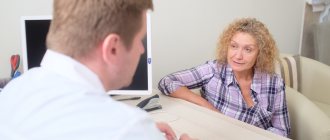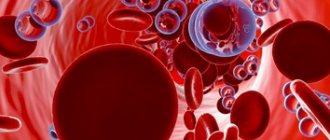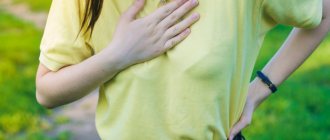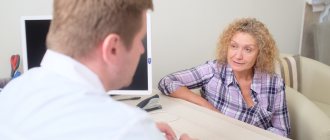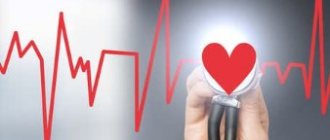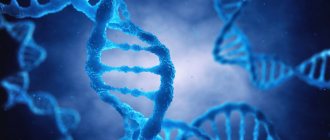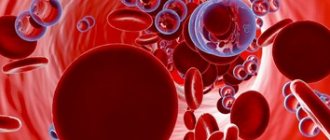During viral infections, the patient needs to ensure that sufficient oxygen enters the lungs. Special techniques can help with this. They should be performed both during illness and for preventive purposes when health deteriorates.
One of the doctors at the Royal London Hospital, answering the question of how to relieve difficulty breathing, recommends doing the following: take a deep breath and hold your breath for 5 seconds, repeat 5 times. The next time you inhale, you need to cough well. Repeat 2 more times, then lie face down on the bed and breathe deeply for 10 minutes. Also, there are other techniques that help with heaviness in the lungs and hard breathing.
Characteristic symptoms
Shortness of breath with coronavirus: how to understand ? It is difficult for the patient to take a deep breath. He makes at least twenty respiratory movements, which is typical for the moderate severity of the disease. As for the severe degree, it is characterized by more than thirty respiratory movements per minute.
At the same time, severe inflammatory processes occur in the lungs: a person’s body temperature rises, but in some situations, shortness of breath with coronavirus without fever , a dry cough is bothersome. But in some cases there may be no symptoms. Then the cough is caused by fear and panic.
If pneumonia is present, during auscultation the doctor hears whistling and wheezing in the bronchi. This is often typical for patients with concomitant bronchial asthma, chronic bronchitis and in the presence of secondary lung damage. Subsequently, if treatment is not timely, edema of the pulmonary tissue may develop - this is a life-threatening condition.
How is it detected?
If you experience symptoms of shortness of breath, you should consult a doctor. First of all, he must check whether the symptom is a sign of physical pathology. To do this, the doctor conducts a survey of the patient, and then proceeds to an objective examination: examines and listens to the patient.
To exclude diseases of internal organs, a number of examinations are prescribed:
- radiography;
- allergy tests;
- CT or MRI;
- ECG, ultrasound of the heart;
- UAC.
Without identifying pathology, the doctor sends the patient to a neurologist or psychotherapist.
The psychotherapist collects a psychogenic history, which includes information about the presence of mental disorders, possible traumatic factors, as well as developmental features in childhood.
Psychological analysis involves the study of personality, including through testing. The Nymigen questionnaire is especially effective, being effective in 90% of cases. It was developed by Dutch pulmonologists. Includes 16 positions characterizing the signs of hot water supply. Their severity is assessed within 0-4 points.
During the neurological examination, neurological symptoms are checked and excessive sweating of the palms and feet is determined. Electromyography may be performed.
Additional examinations include hyperventilation test, acid-base blood test, and electrolyte balance. As a rule, with neurogenic shortness of breath, a deficiency of magnesium and calcium in the blood is detected.
What are the characteristics of breathing complications after suffering from covid-19?
Symptoms of shortness of breath with coronavirus:
- feeling of tightness in the chest,
- rapid breathing,
- superficial breathing movements,
- It's difficult to take a deep breath.
coronavirus shortness of breath symptoms
The presence of shortness of breath in healthy people does not always indicate pathology. It can normally occur in athletes and runners. It can also occur in ordinary people during physical activity. But after suffering from covid-19, shortness of breath occurs even at rest, the body is starved of oxygen, which disrupts its vital functions.
How to understand that you need a doctor's help
It is not always possible to independently determine the causes of shortness of breath during exercise or at rest. A pulmonologist will help with this; you should make an appointment with him if you experience shortness of breath and have trouble breathing . In case of an acute sudden attack with a significant deterioration in well-being, the patient needs emergency help. If you are concerned about shortness of breath and lack of air without exercise , then you need to visit a doctor as planned.
At your appointment, the pulmonologist will ask a number of questions, the answers to which will allow you to determine the exact cause of shortness of breath when walking , exercising, or at rest. List of main questions:
- how long has the symptom bothered you?
- severe shortness of breath occurs when walking and running or bothers you even when resting;
- which is more difficult - inhalation or exhalation;
- will the condition stabilize if you lie down;
- Are there any accompanying symptoms?
What types of shortness of breath are there after coronavirus?
Doctors distinguish two types of shortness of breath after coronavirus , which occur in patients in this group:
- Emerging gradually. A person feels difficulty during inhalation and exhalation not only during exercise, but also at rest. Worsening occurs at night, and signs of suffocation may occur. When you raise your arms up, the patient's condition is better.
- Sudden shortness of breath. It occurs against a background of complete well-being and is accompanied by headache and sweating. It is impossible to take a full breath, the fear of death arises.
Both options require emergency medical attention. Because at any moment the patient’s condition may worsen and breathing will become impossible. Now you know what shortness of breath is like with coronavirus .
Development mechanism and distinction criteria
Each activity, including breathing, is regulated by a specific part of the brain. In a state of stress and nervous overstrain, the central and peripheral nervous systems fail. Control over the breathing center in the brain is lost, overexcitation spreads, resulting in faster breathing.
The lungs become overfilled with air, causing hypocapnia, that is, the amount of oxygen in the blood increases excessively, and carbon dioxide decreases below normal. This imbalance of gases causes an attack of psychogenic shortness of breath.
Despite the fact that the symptoms of its manifestation are similar to true shortness of breath, there are still some criteria that allow it to be differentiated:
| Types of shortness of breath Criteria | Psychogenic | True |
| Cause | Examination of internal organs fails to detect | Pathology of the heart, kidneys, lungs, etc. |
| Bodily symptoms | None | Pale or cyanotic skin, barrel chest, edema |
| Changing body position | Does not affect breathing pattern | A change in position can alleviate or provoke a pathological symptom. It often intensifies especially after physical activity. |
| Nature of violations | Fickle | Constant |
| Periodicity | It worsens due to the weather, at certain times of the day (for some, attacks occur in the morning, for others - at night). It appears more often in spring and autumn. | |
| Cough | Not controlled by medications | In some cases, it can be treated with medication |
| Switching attention | All symptoms go away if you move the conversation in a different direction | Shortness of breath persists, no connection |
How to assess lung function after coronavirus?
A breath test should be performed. You can do it yourself at home:
- take a deep breath through your nose,
- hold your breath for ten seconds,
- exhale slowly.
In the absence of any discomfort, cough or sore throat, the lungs are healthy. If your health worsens and these symptoms occur, you should immediately seek medical help. You can find a video on the forum on how to properly do a lung assessment.
How to get rid of the feeling of suffocation
The question of how to treat psychogenic dyspnea includes a wide range of methods.
But the main thing is to restore a favorable psychological background. Only nervous calm will help eradicate the disease completely.
You can try to do this on your own.
- Take herbal infusions.
- Set up a daily routine. Sleep – at least 8 hours. Avoid overwork.
- Give up bad habits, as they produce a psychostimulating effect.
- Workout.
- Proper nutrition - more fruits and vegetables, less fatty, salty and spicy foods. It would be good to diversify the menu with products high in magnesium: pumpkin and sunflower seeds, nuts, wheat bran, dates, spinach, cocoa.
- Warm flavored, massage, hardening.
- Breathing exercises – helps to increase the level of CO2 in the blood and reduce the breathing rate.
It happens that neurogenic breathing disorder goes away on its own. For this, a change in the situation was enough, both in a positive and negative direction.
Here is the story of a guy who suffered from nervous shortness of breath for a long time and got rid of it without noticing it. The young man suffered from the disease for 6 years, starting at the age of 15. Attacks of suffocation plagued him so much that he was afraid to go outside for fear of suffocating. After a long examination, a diagnosis was made: “hyperventilation syndrome.”
Upon reaching conscription age, he was drafted into the army (he turned out to be fit). This fact added even more panic. The service was akin to hell. But six months later he suddenly realized that the attacks had subsided. He could finally breathe deeply. There was a feeling that a second wind had opened, and for him it was on the verge of bliss. The disease no longer bothered him.
If you cannot cope with the disease on your own, you will have to resort to the help of specialists and medications.
- Psychotherapy.
- Prescription of sedatives, antidepressants and tranquilizers. Vitamins B, D, magnesium and calcium preparations, as well as beta blockers.
- Special devices that train breathing and help normalize its rhythm. They restore respiratory frequency and relax muscles. Therapy takes place in the form of a game, allowing you to develop self-control, improve your psycho-emotional background, and increase resistance to stress factors.
- Physiotherapy – magnetic therapy, electrophoresis, galvanization, mud therapy.
- Sanatorium-resort holiday.
Nervous shortness of breath, while not a sign of physical pathology, is nevertheless dangerous to health. Its occurrence requires immediate therapeutic intervention to prevent persistent mental disorders and personality changes.
Self-diagnosis problems
Difficulty breathing, for example, during nasal congestion and when the functioning of the lungs is impaired, are completely different things. It is impossible to figure out the cause of shortness of breath on your own.
treatment of shortness of breath due to coronavirus
You should seek medical help from your family doctor or pulmonologist. You should not self-medicate.
Night guest
False croup, or stenosing laryngotracheitis, is one of the manifestations of ARVI. It occurs in the larynx, where swelling forms, which interferes with the breathing process. A viral disease does not necessarily have to be severe for an attack to develop. Sometimes the child had only a slight runny nose and a slight cough the day before.
As a rule, false croup occurs closer to the night, but a few hours before this, the child already begins to experience warning signs. Due to the narrowing of the airways, the baby's voice becomes hoarse and a whistling sound appears when breathing. Hearing this, sometimes parents begin to suspect that their child has begun to develop bronchial asthma. But in fact, any doctor who hears such a sound will understand that this is not so. Indeed, with obstruction of the lower respiratory tract (bronchial asthma), the patient inhales normally (problems arise only with exhalation), but with false croup, on the contrary, it is not exhalation that is difficult, but inhalation. The child inhales noisily, making the so-called inspiratory breath. In addition, with false croup, a special cough occurs - barking. For some, it resembles the caw of a crow or even the sound of iron on glass. As the airway narrows, symptoms increase, requiring emergency medical attention. If necessary, emergency doctors will give the child an injection of glucocorticosteroids. Of course, not every child’s false croup can reach the suffocation phase, but if there is a predisposition to such a complication, it is better to have such drugs in your home medicine cabinet.
Treatment of shortness of breath after suffering from covid-19
Shortness of breath after coronavirus, what to do ? If you have difficulty taking a deep breath, after additional diagnostics, doctors prescribe:
- drug therapy,
- oxygen therapy,
- inhalations,
- physiotherapy,
- breathing exercises.
Later in the article we will talk in more detail about each treatment method.
Medicines for shortness of breath
Many people are interested in the question: how to treat shortness of breath with coronavirus ? To relieve symptoms, doctors prescribe drugs from the following groups:
- bronchodilators,
- expectorants,
- antiviral drugs,
- immunomodulators,
- antibacterial drugs.
The doctor selects the drug and its dosage individually depending on the severity of the symptoms, the clinical picture and the presence of concomitant pathology in the individual patient.
Oxygen therapy (oxygenation)
It is an oxygen inhalation, which is used in case of shortness of breath without coronavirus . Oxygen is introduced into a person's respiratory tract using a special tube.
Oxygenation is used only in patients with severe forms of pathology, with extensive lung damage. If all medical recommendations are followed, the risk of such complications is minimal.
Inhalation therapy
It is used using a Nebulizer, which allows you to administer drugs in the form of microparticles dissolved in the air into the patient’s respiratory tract. A good effect can be achieved by using:
- phlegm thinners,
- sea water,
- saline solutions,
- antiseptics,
- bronchodilators,
- expectorants.
This method should be used only as prescribed by a doctor so as not to harm the functioning of the lungs.
Physiotherapy
In order to accelerate the resorption of pathological foci and relieve inflammation after suffering from covid-19, the following should be carried out:
- chest massage,
- electrophoresis,
- SMT,
- UHF therapy.
Please note that you should complete the full course of procedures to achieve a good treatment result.
Breathing exercises
It is worth doing the exercise both during the disease itself and after it has been cured and a negative test has been received. These exercises will strengthen your chest muscles and increase blood flow to your lungs.
Can I improve my lung function on my own?
Can! There are quite simple methods for this:
- It is necessary to consume fresh vegetables and fruits as much as possible. Tomatoes, blueberries, nuts, onions and citrus fruits are especially beneficial for the lungs. Fatty foods, spices and smoked foods should be avoided.
- You shouldn't smoke. Tobacco smoke provokes the occurrence of inflammatory diseases, while the resistance of the lungs to viral and bacterial pathologies weakens. The relationship between tobacco smoke and the occurrence of cancer has also been proven. To speed up the process of recovery of lung tissue, you should abstain from smoking.
- Cardio exercise (this can be jogging at a moderate speed, walking at speed, jumping rope). They should be performed if you feel well. They help strengthen the heart muscle, normalize blood circulation, increase the respiratory volume of the lungs and build endurance. Training should be done outdoors. Increase the load gradually. If you feel the slightest deterioration in health, the training should be interrupted.
- Eliminate negative environmental factors and smoke. After suffering from covid-19 with accompanying symptoms ( shortness of breath, coronavirus pneumonia ) in the early period after the disease, you should not be in polluted conditions. If there are harmful professional conditions, it is better to take a vacation. Spend more time outdoors, ideally visit a sanatorium or health resort in a pine forest or on the seashore.
Anyone who listens to the doctor’s recommendations, takes medications on time, eats right, engages in dosed physical activity and walks in the fresh air will quickly get rid of the consequences of covid-19. Be attentive to your health and seek specialized medical help when the first symptoms of illness appear.
What is shortness of breath and what causes it?
Shortness of breath refers to a whole range of symptoms. The main symptom of dyspnea is a feeling of ineffectiveness of the breathing movements performed. The person realizes that he doesn’t have enough air. He experiences chest tightness and general discomfort. Severe shortness of breath and palpitations are often combined . In this condition, your heart rate may increase.
Associated symptoms:
- respiratory rhythm disturbance - too frequent or rare breathing;
- suffocation;
- paleness of body skin;
- cyanosis (blueness) of the nasolabial triangle;
- dizziness;
- tinnitus.
The typical reaction of a person if shortness of breath appears is to stop any activity and find support. As a rule, if you sit or lie down, the condition will stabilize on its own after a few minutes. This technique works if the cause of shortness of breath and lack of air is excessive physical activity or severe emotional stress.
The mechanism of development of dyspnea is associated with the work of the body's reflex mechanisms. This is a kind of reaction to a change in the ratio of oxygen and carbon dioxide in the blood. As the concentration of carbon dioxide increases, the pH level decreases, which leads to stimulation of the receptors in the medulla oblongata. Next, the protective mechanism is triggered. A signal goes from the respiratory center to the periphery, stimulating increased breathing, the purpose of which is to increase the concentration of oxygen in the blood and increase its saturation. This mechanism most often causes severe shortness of breath and respiratory rhythm disturbances.
Types of dyspnea
Experts distinguish three groups of shortness of breath. The classification is based on provoking factors and the difficult breathing phase.
- Inspiratory. Difficulty breathing. Noisy breathing may occur. often occurs with pulmonary fibrosis, pathologies of the diaphragm, and heart failure.
- Expiratory. The patient experiences difficulty exhaling, which is typical for asthma, bronchitis, and emphysema.
- Mixed. Both phases of breathing are impaired. Most often it is a consequence of cardiac pathologies and diseases of the central nervous system.
How to deal with shortness of breath?
If a person begins to have breathing problems, he, of course, tries to cope with this situation. At the same time, as doctors note, shortness of breath is not so easy to deal with. “Most often, shortness of breath indicates that the gas exchange system in the pulmonary alveoli is disrupted and oxygen does not penetrate well into the body tissues. Therefore, it is worth first checking for three factors: either a pulmonary cause causes this condition, or a cardiac hemocirculatory problem is present, or the transfer of oxygen by hemoglobin is ineffective,” notes the Honored Doctor of Russia.
A person himself is unlikely to be able to cope with his shortness of breath, because there are no available means that will help remove a negative symptom without identifying and correcting the causes. To ease the condition, you can open the window wider, unbutton your shirt and loosen your tie. “But these are all just instinctive measures that will relieve shortness of breath,” notes Alexander Karabinenko.
In fact, medical help is needed. Only a doctor can correctly understand a person’s condition and prescribe the necessary examinations. “To treat severe shortness of breath, the use of special equipment and respiratory support is required. But only a doctor should determine how much such support a person needs. And, of course, a thorough examination of the person for shortness of breath will be required,” notes the pulmonologist. Methods of respiratory support include, for example, oxygen therapy or mechanical ventilation. It is clear that the purpose of each method must correspond to the condition and needs of the patient.
Insomnia, shortness of breath and pain in the back of the head. Patients about life after COVID-19 Read more

